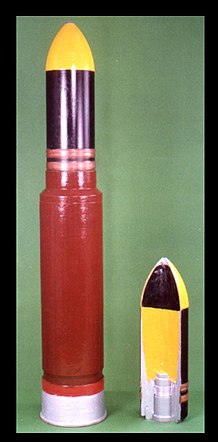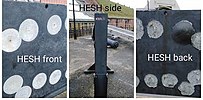High-explosive squash head
(HESH)
Ahigh-explosive squash head(HESH), in British terminology, or ahigh-explosive plastic/plasticized(HEP), in American terminology,[1]is a type ofexplosiveprojectilewith plastic explosive that conforms to the surface of a target before detonating, which improves the transfer of explosive energy to the target. Squash head projectiles are similar to high-explosive projectiles and are well suited to many of the same targets. However, while HESH projectiles are not armour-piercing, they can defeat armored targets by causingspall,which can injure or kill a vehicle's occupants or detonate some types of ammunition.[2]
Design[edit]
| External videos | |
|---|---|
Function[edit]
HESH rounds are thin metal shells filled withplastic explosiveand a delayed-actionfuzeat the base of the shell.[3]On impact, the inert material, followed by plastic explosive, is 'squashed' against the surface of the target and spreads out to form a disc or 'pat' of explosive. The inert material helps prevent premature detonation of the plastic explosive and sustains the impact pressure and temperature.[3][2]
Milliseconds later, the base fuze detonates the explosive, creating ashock wavethat, owing to its large surface area and direct contact with the target, is transmitted through the material. In the metal armour of a tank, the compression shock wave is conducted through the armour to the point where it reaches the metal-air interface (the hollow crew compartment), where some of the energy is reflected as a tension wave, a phenomenon calledimpulsive loading.At the point where the compression and tension waves intersect, a high-stress zone is created in the metal, causing pieces of steel to be projected off the interior wall at high velocity.[2]
-
Shell design:charge,fuze,shell
-
Function of HESH-munition
Effect[edit]
This fragmentation by blast wave is known as 'scabbing' or 'spalling', with the fragments termed 'scabsor 'spall'.[4][2]
Depending upon the armour thickness, a heavy piece of target material (4 to 10 kg (8.8 to 22.0 lb) for a 120 mm (4.7 in) round used inArjun MBT[4]) can separate out from the other end of the target with supersonic velocities. This spall is sufficient to permanently damage the essentials of a tank, igniting the ammunition or fuel storage and severely damaging the crew to achieve a "total kill" of the target. In general, the higher the armour thickness, the higher the scab weight will be.[2]
The fragmentation achieved by impulsive loading of armour block by a HESH round is more lethal than similarhigh explosiverounds.[4][2][clarification needed]
-
Front and back side of armour block impacted by HESH rounds
-
Light spalling damage caused by HESH rounds
-
Heavy spalling damage caused by HESH rounds
Use[edit]
HESH rounds are mostly fired from guns withrifled,rather thansmoothbore,barrels. Rifling causes a projectile to spin, thereby allowing longer projectiles to be used, while at the same time improving accuracy. This also may make a HESH shell more effective on impact by increasing the surface area of contact for the explosive: the faster the spin, the larger the resultant contact patch. HESH shells are not specifically designed to perforate the armour of vehicles, unlikehigh-explosive anti-tank(HEAT) rounds, with theirshaped chargejets. HESH shells rely instead on transmitting a shock wave through the solid steel armor.[2][5]
HESH ammunition has good general purpose use, being effective against most targets, though the round is generally used at relatively low velocities (generally under 800 m/s (2,600 ft/s)) because high velocity excessively disperses the pat of explosive. While only effective against tanks withoutspaced armouror spall liners, the round is still favoured for combatdemolitionpurposes. The flattened high-velocity explosive pat can destroy concrete constructions much faster than a HEAT round (which is designed to penetrate armour), and without the dangerous fragmentation of a traditionalhigh explosive(HE) fragmentation round.[3]
History[edit]
HESH was developed byDennistoun Burneyin the 1940s for the British war effort, originally as an anti-fortification"wallbuster" munition for use against concrete. He also led British developments inrecoilless riflesas a means to deliver the shell. An early application of the HESH principle post WWII was theL9 165 mm demolition gunfitted toAVREcombat engineer vehicles.[6]
HESH was found to be surprisingly effective against metallic armour as well as concrete structures. It was widely used as a primary round in most large calibre rifled guns.
Users[edit]


HESH rounds were fielded mainly by theBritish Armyas the main explosive round of itsmain battle tanksduring theCold War.It was also used by other military forces, especially those that acquired the early post-World War II British 105 mm (4.1 in)Royal Ordnance L7A1tank gun, including Germany, India, Israel, and Sweden.
Since the 1980s, HESH ammunition has increasingly lost favour as armour designs have trended towards layered composites of hard metal and heat-resistant materials. This type of armour conducts shock waves poorly. Anti-spalling devices (spall liners), made of materials such asKevlar,are commonly fitted to the interior surface of modern armoured vehicles to minimise spalling effects.[7]Another reason for the declining use of HESH rounds is the preference of most armies using smoothbore guns due to the usage of powerfularmour-piercing fin-stabilized discarding sabot,which would significantly decrease the rifled gun's barrel life.
BritishChallenger 1andChallenger 2tanks, and India'sArjun tank(which has the same rifled 120 mm (4.7 in) gun as the UK's MBTs) use HESH rounds as their primary ammunition. Amongst other ammunition types, theStryker Mobile Gun Systemvariant is to be equipped with a 105 mm (4.1 in) HESH round for demolition and bunker-busting purposes. Argentina'sTAM medium tanks,Canada'sLeopard C1andLeopard C2main battle tanks (all of which mount the same 105 mm (4.1 in) gun as the Centurion), the AustralianLeopard AS1main battle tank, and the ChineseVT-4 main battle tank(which mounts a 125 mm (4.9 in) smoothbore gun) all use HESH rounds.
HESH rounds are also carried byarmoured engineer vehicles;they are typically intended for use againstfortificationsrather thanarmoured fighting vehicles.A 165 mm (6.5 in) HESH round is used by theUnited States Armyfor the main gun of theM728 combat engineer vehicle,anM60 tankequipped with abulldozerblade. Similarly, the UK'sCenturion AVREwas equipped with a short 165 mm (6.5 in) gun solely for a 29 kg (64 lb) HESH shell.
See also[edit]
References[edit]
- ^"Explosive_weapon_effects_web.pdf"(PDF).gichd.org.p. 22.Retrieved2021-10-10.
- ^abcdefgDeshpande, P.U.; Prabhu, V.D.; Prabhakaran, K.V. (2003-10-01)."Impulsive Loading of Armour by High Explosive Squash Head Munition".Defence Science Journal.53(4): 357–365.doi:10.14429/dsj.53.2282.
- ^abcRoy, S. N., Armament Research & Development Establishment, Kirkee (29 March 2014)."Some design and functional aspects of squash head shell".Defence Science Journal.12(1): 55–58.doi:10.14429/dsj.12.6834(inactive 31 January 2024).
{{cite journal}}:CS1 maint: DOI inactive as of January 2024 (link) CS1 maint: multiple names: authors list (link) - ^abc"120 mm High Explosive Squash Head Mark-I".Defence Research and Development Organisation(DRDO), Government of India.Design aspects of 120 mm HESH round forArjun MBT
- ^"115 mm, 120 mm & 125 mm Tank Guns".GICHD.Retrieved2021-10-04.
- ^Edgerton, David (2012).Britain's war machine: weapons, resources and experts in the Second World War.London: Penguin. Chapter-8 Boffins.ISBN978-0-14-102610-7.OCLC761379325.
- ^"Modern Anti-Tank Ammunition".The Ontario Regiment RCAC Museum.2021-07-30.Retrieved2021-10-02.






